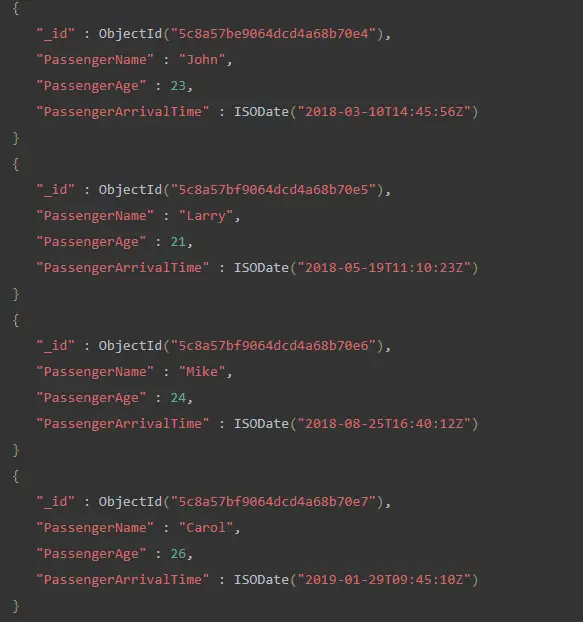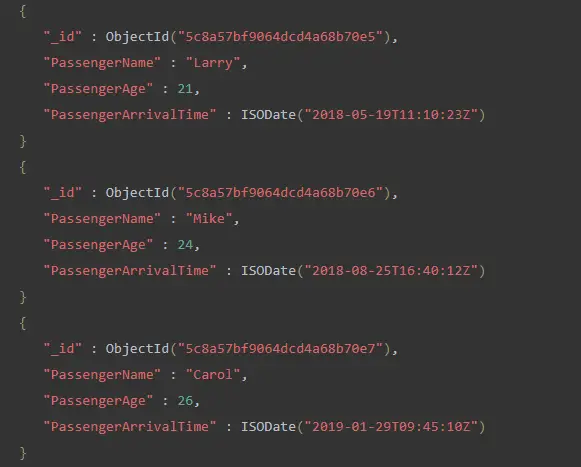Returning Date-Based Queries in MongoDB
In this MongoDB article, the problems with returning queries based on dates are pointed out. In addition, it explains in detail how to query using date ranges in MongoDB.
Using date range queries in MongoDB
This section will show you how to write a MongoDB date range query to fetch records based on a timestamp. Examples of MongoDB date queries include MongoDB date is greater than or less than a time or date, etc.
grammar:
db.collection.find({
day: {
$gt: ISODate("2020-01-21"),
$lt: ISODate("2020-01-24")
}
})
This query returns all documents in the collection daywhere the field is greater than 2020-01-21and less than .2020-01-24
The instructions shown above are easy to understand. However, there are slight differences between these instructions.
You can use $gteto indicate this 大于或等于.
gte = greater than or equal to i.e >=
$gtexpress 大于.
gt = greater than i.e >
$lteUsed for 小于或等于.
lte = less than or equal to i.e <=
$ltexpress 小于.
lt = less than i.e <
The following information shows how to use this syntax in practice with collection data that has the following documents:
db.data.insertOne({day: new Date("2022-01-20"), amount: 40})
db.data.insertOne({day: new Date("2022-01-21"), amount: 32})
db.data.insertOne({day: new Date("2022-01-22"), amount: 19})
db.data.insertOne({day: new Date("2022-01-23"), amount: 29})
db.data.insertOne({day: new Date("2022-01-24"), amount: 35})
Find documents between two dates in MongoDB
You can use the following query to find dayall documents where the field is between two specific dates:
db.data.find({
day: {
$gt: ISODate("2020-01-21"),
$lt: ISODate("2020-01-24")
}
})
Output:
{ _id: ObjectId("618548bc7529c93ea0b41490"),
day: 2020-01-22T00:00:00.000Z,
amount: 19 }
{ _id: ObjectId("618548bc7529c93ea0b41491"),
day: 2020-01-23T00:00:00.000Z,
amount: 29 }
Find documents after a specific date in MongoDB
You can use the following query given below to find dayall documents where the field is after a specific date:
db.data.find({
day: {
$gt: ISODate("2020-01-22")
}
})
Output:
{ _id: ObjectId("618548bc7529c93ea0b41491"),
day: 2020-01-23T00:00:00.000Z,
amount: 29 }
{ _id: ObjectId("618548bc7529c93ea0b41492"),
day: 2020-01-24T00:00:00.000Z,
amount: 35 }
Find documents before a specific date in MongoDB
You can use the following query given below to find dayall documents where the field is before a specific date:
db.data.find({
day: {
$lt: ISODate("2020-01-22")
}
})
Output:
{ _id: ObjectId("618548bc7529c93ea0b4148e"),
day: 2020-01-20T00:00:00.000Z,
amount: 40 }
{ _id: ObjectId("618548bc7529c93ea0b4148f"),
day: 2020-01-21T00:00:00.000Z,
amount: 32 }
Returning Date-Based Queries in MongoDB
Let's look at an example of how to return a query based on a date in MongoDB.
Let us create a datacollection called with the document to grasp the concept better. Following is the query to build a collection containing records:
db.data.insertOne({"PassengerName":"John","PassengerAge":23,"PassengerArrivalTime":new ISODate("2018-03-10 14:45:56")});
{
"acknowledged" : true,
"insertedId" : ObjectId("5c8a57be9064dcd4a68b70e4")
}
db.data.insertOne({"PassengerName":"Larry","PassengerAge":21,"PassengerArrivalTime":new ISODate("2018-05-19 11:10:23")});
{
"acknowledged" : true,
"insertedId" : ObjectId("5c8a57bf9064dcd4a68b70e5")
}
db.data.insertOne({"PassengerName":"Mike","PassengerAge":24,"PassengerArrivalTime":new ISODate("2018-08-25 16:40:12")});
{
"acknowledged" : true,
"insertedId" : ObjectId("5c8a57bf9064dcd4a68b70e6")
}
db.data.insertOne({"PassengerName":"Carol","PassengerAge":26,"PassengerArrivalTime":new ISODate("2019-01-29 09:45:10")});
{
"acknowledged" : true,
"insertedId" : ObjectId("5c8a57bf9064dcd4a68b70e7")
}
This will find()display all the documents in the collection with the help of method. The query for this is as follows:
db.data queryFromDate.find().pretty();
Output:

This is a return query based on date. 2018-05-19T11:10:23ZRecords with dates after will be displayed as,
> db.data queryFromDate.find({"PassengerArrivalTime" : { $gte : new ISODate("2018-05-19T11:10:23Z") }}).pretty();
Output:

in conclusion
With the help of this article, you have gained Date()information about using the and commands. In addition, $gtethe and $ltecommands will be explained with examples.
The query based on date return is also illustrated with code snippets.
For reprinting, please send an email to 1244347461@qq.com for approval. After obtaining the author's consent, kindly include the source as a link.
Related Articles
List all collections in MongoDB Shell
Publish Date:2025/04/29 Views:156 Category:MongoDB
-
When using MongoDB , there are several ways to list the collections in the database. This article will discuss four different ways to get a list of collections in a MongoDB database. These methods are as follows: show collections List all c
Querying for non-null values in MongoDB
Publish Date:2025/04/29 Views:139 Category:MongoDB
-
This MongoDB article will explain how to query for non-null values in MongoDB. To query for non-null values, you can use $ne the operator and $eq the operator and then specify the desired value to query. This article shows the readers
Shutting down with code:100 error in MongoDB
Publish Date:2025/04/29 Views:53 Category:MongoDB
-
This MongoDB tutorial will teach you to fix the error on different operating systems shutting down with code:100 . It will also talk about the root cause of why this issue occurs. shutting down with code:100 Errors in MongoDB As we all know
SELECT COUNT GROUP BY in MongoDB
Publish Date:2025/04/29 Views:74 Category:MongoDB
-
In this article, we will discuss the functions in MongoDB. Also, we will point out the aggregation functions in detail. We will explain in detail the different ways to count and sort multiple and single fields of Group in MongoDB. Operation
Differences between MongoDB and Mongoose
Publish Date:2025/04/29 Views:80 Category:MongoDB
-
This MongoDB article will discuss the differences between MongoDB and Mongoose. Unfortunately, most beginners tend to confuse these two concepts when they start developing applications and use MongoDB as their backend. MongoDB has its own s
Install MongoDB using Homebrew
Publish Date:2025/04/29 Views:161 Category:MongoDB
-
MongoDB is a well-known unstructured database management system that can handle large amounts of data. It is a document-oriented database system and belongs to the NoSQL family (non-SQL). Data and records are stored as documents that look a
Create a MongoDB dump of the database
Publish Date:2025/04/29 Views:62 Category:MongoDB
-
In this MongoDB article, you’ll get a walkthrough of Mongodump and Mongorestore , how to use them, and some simple examples of backing up and restoring your collections using both tools. mongodump Commands in MongoDB Mongodump is a tool t
Get the size of the database in MongoDB
Publish Date:2025/04/29 Views:88 Category:MongoDB
-
When working in MongoDB, do you know the size of your database? Today, we will learn how to get the size of a database in MongoDB using show dbs the command and the method. db.stats() Get the size of the database in MongoDB We can show dbs;
Grouping values by multiple fields with MongoDB
Publish Date:2025/04/29 Views:99 Category:MongoDB
-
MongoDB Group by Multiple Fields is used to group values by multiple fields using various methods. One of the most efficient ways to group various fields present in MongoDB documents is by using $group the operator, which helps in per

